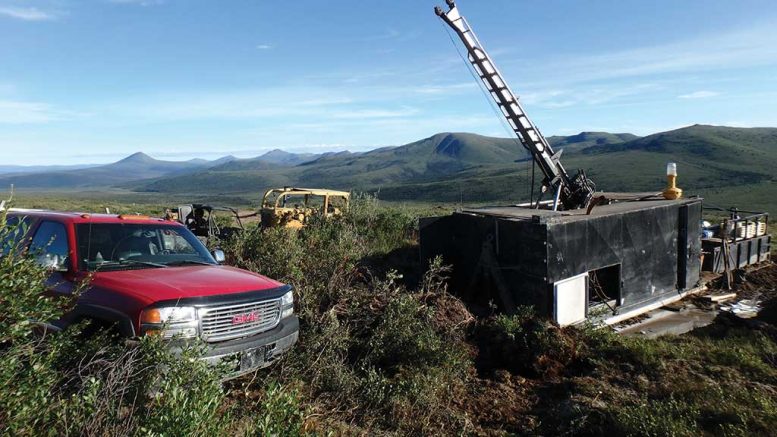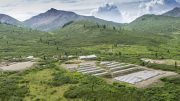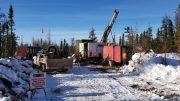Mike Burke has been working as a geologist in the Yukon since 1990. He’s seen a lot of smaller discoveries, but says the territory still hosts company-defining gold deposits.
“When you look at the [Pacific] Cordillera — whether it’s Alaska, Yukon, British Columbia or down through the U.S. — it’s a real mélange of complicated, but very prospective geology … when you look at the Yukon, which is perched in the middle of that, it is definitely the most underexplored of those regions,” he says.
Burke attributes the lack of exploration mostly to the Yukon’s remote location and short summers.
“Ten years in the Yukon is five years in Ontario, when it comes to exploration,” Burke says.
Burke says middle Cretaceous intrusions extend across the Yukon, and some of those intrusive events are associated with gold. The first major, intrusive-hosted gold discovery along the Tintina fault was Fort Knox, 42 km northeast of Fairbanks, Alaska.
The prolific low-grade, bulk-tonnage mine entered production in 1996 and has produced more than 7 million equivalent oz. gold for Kinross Gold (TSX: K; NYSE: KGC), and it should run until at least 2020.
Burke says the Fort Knox discovery led geologists to seek more “tombstone-type” intrusive deposits, which led to Yukon’s first big gold mine — Brewery Creek, 55 km east of Dawson.
Over six up-and-down years Brewery Creek produced 280,000 oz. gold from seven shallow oxide deposits. Low gold prices forced Viceroy Resource Corp. to shutter the marginal operation in 2002.
The modest gold mine is the Yukon’s biggest to date. But that could soon change due to orogenic deposits (formed as mountains are formed) found in a geological package southwest of Brewery Creek.
Goldcorp (TSX: G; NYSE: GG) is developing the high-grade Coffee project, 130 km south of Dawson. It was acquired with its $520-million Kaminak Gold takeover in 2016. Coffee has proven and probable reserves of 2.16 million ounces. But Goldcorp says Coffee could grow into a “district-scale” operation.
Coffee is part of a series of orogenic vein deposits known as the White Gold District, which lies south of Dawson along the 1,200 km long Tintina gold belt, made famous by the Klondike gold rush of 1896. Some estimates put the placer gold recovered along the belt at between 13 and 20 million ounces. But no one has ever found its source.
The White Gold District formed in 2008 when Underworld Resources intersected 4.1 grams gold per tonne over 18 metres at its White Gold property, 95 km south of Dawson, which was optioned from local prospector Shawn Ryan. But before the junior could publish even a prefeasibility study, Kinross swooped in and bought Underworld in a share-based takeover worth $140 million.
That acquisition sparked interest that led to 50,000 claims staked in the region between 2009 and 2012. More than 7 million oz. gold have been found in other deposits since.
Comstock Metals (TSXV: CSL) came onboard in mid-2012 when the junior intersected 3.04 grams gold per tonne over 45.5 metres in the VG zone, which is part of its flagship QV project, also optioned from Shawn Ryan.
Drilling in 2017 extended gold mineralization in the VG zone farther west. Some highlights include drill hole 17-018, which hit 45.5 metres averaging 1.42 grams gold, starting at 67.5 metres downhole; and hole 17-019, which returned 51.2 metres averaging 1.48 grams gold, starting at 98 metres downhole.
Not far away, Golden Predator Mining (TSXV: GPY) did a preliminary economic assessment on the past-producing Brewery Creek mine in 2014. The project hosts an indicated resource of 17.6 million tonnes running 1.7 grams gold for 719,000 contained ounces. Another 825,000 oz. gold are in the inferred category.
However, the Bill Sheriff-led junior is mostly focused on its 3 Aces project, an orogenic gold system that the company says has “district potential.”
More than 20,000 metres of drilling has confirmed gold mineralization in quartz veins across the project, and a 776-tonne bulk sample taken in 2016 yielded 953 oz. gold.
More drilling will be done in 2018, and another bulk sample will be taken from the Spades zone. McEwen Mining (TSX: MUX; NYSE: MUX) owns 4.25% of Golden Predator.
The White Gold District was a bona fide area play until the gold price sagged in 2013, and exploration capital largely evaporated.
In 2017, Kinross agreed to sell its once celebrated White Gold property to the eponymous White Gold (TSXV: WGO) in exchange for $10 million and a 19.9% position in the junior (as well as some deferred payments if certain criteria are met). Shawn Ryan is the company’s chief technical advisor.
Agnico Eagle Mines (TSX: AEM; NYSE: AEM) also owns a 19.9% stake in White Gold Corp., which recently published a resource estimate of 961,000 indicated oz. gold, with another 282,500 inferred oz. gold over both the Golden Saddle and Arc deposits on the White Gold property.
The junior is the largest landowner in the White Gold District, with 19,438 claims covering 3,900 sq. kilometres.
In addition to the Kaminak purchase, Goldcorp has 19.9% stakes in Independence Gold (TSXV: IGO) and Triumph Gold (TSXV: TIG; US-OTC: TIGCF).
Independence is having a go at its Boulevard project. So far, the company has found 25 gold-in-soil anomalies in three zones: Sunrise/Sunset, Denali and Runway.
A total of 978 metres of diamond drilling over nine holes were done on the Sunrise/Sunset zone last year. The best intercept returned 3.1 grams gold over 1.5 metres. The company is also exploring its Moosehorn, Wolf Creek and Stinger properties in the White Gold District.
Triumph is investigating its 200 sq. km Freegold Mountain project. The junior is drilling 1,900 metres on the Keirsten Zone to test a porphyry system the company hit during 2017 exploration work.
Triumph vice-president of exploration Tony Barresi says the company’s Revenue and Nucleus deposits on the Freegold Mountain project are parts of a “5 to 6 km long magmatic-hydrothermal mineralizing system” with porphyry and epithermal components. The Keirsten Zone occurs between Revenue and Nucleus.
Just south of the Freegold Mountain project lies Rockhaven Resources’ (TSXV: RK) advanced-stage, wholly owned Klaza gold-silver project in the Dawson Range gold belt.
Rockhaven has drilled more than 90,000 metres over 434 holes since 2010. Drill hole 401 on the Western BRX zone in 2017 hit 2.6 metres of 94 grams gold, 545 grams silver, 2.8% lead and 4.2% zinc.
The Western BRX Zone hosts an inferred mineral resource estimate of 1,368,000 tonnes containing 352,000 oz. gold, 5,813,000 oz. silver, 39.4 million lb. lead and 42.8 million lb. zinc at an average grade of 8.01 grams gold per tonne, 132 grams silver, 1.31% lead and 1.42% zinc.
The 2016 inferred resource estimate for both the underground and open-pit of Klaza totals 9.42 million tonnes grading 4.48 grams gold, 89.02 grams silver, 0.75% lead and 0.95% zinc for 1.358 million oz. gold, 26.96 million oz. silver, 155.41 million lb. lead and 197.89 million lb. zinc. The cut-off grade for the pit is 1.3 grams gold. The underground cut-off grade is 2.75 grams gold.
Coeur Mining (NYSE: CDE) owns a 9.9% stake in Rockhaven.
Meanwhile, Goldstrike Resources (TSXV: GSR) is exploring the Lucky Strike property, 24 km northeast of the Coffee project, in the White Gold District. In late 2017 hole 17-09, which defined Lucky Strike, returned 5.36 grams gold over 22 metres. The company owns a 150 sq. km land package in the area with no underlying royalties or outstanding property payments.
Newmont Mining (NYSE: NEM) has a US$39.5-million earn-in agreement at Goldstrike’s Plateau gold project farther north.
In east-central Yukon, Barrick Gold (TSX: ABX; NYSE: ABX) has taken 19.9% in Atac Resources (TSXV: ATC), which is developing the 1,700 sq. km Carlin-style Rackla gold property.
Both companies will spend $13 million to conduct 20,000 metres of diamond drilling on Rackla mid-year, including step-out drilling from 2017 results of 12.5 metres of 20.78 grams gold at the Conrad zone, and 15.2 metres of 13.52 grams gold at the Sunrise zone.
Under an April 2017 earn-in agreement, Barrick can acquire up to a 70% interest in the 780 sq. km Orion project (part of Rackla) by spending $63.3 million ($8.3 million in a flow-through private placement in 2017, plus $55 million on exploration). TNM
— Based in Toronto, Brian Sylvester is a freelance business writer specializing in mining.






Why is Victoria Gold (VIT) NOT MENTIONED IN YOUR ARTICLE?